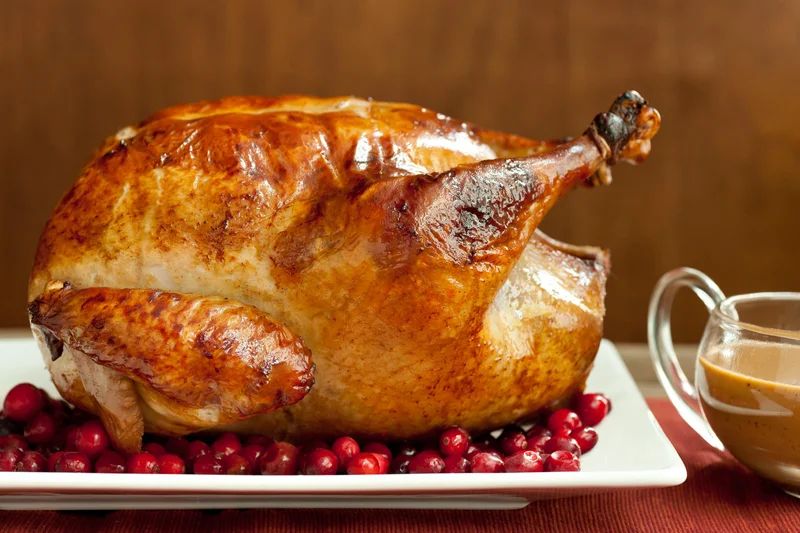Brining a turkey yields juicy, perfectly seasoned results, but the method can seem like an ordeal, hoisting the turkey into a chest cooler to cure out in the garage. Using your refrigerator’s crisper drawer, however, makes brining hassle-free. Start by heating the brine ingredients, letting the mixture cool, pouring it into a large resealable bag, and adding the bird. Place the turkey in the crisper drawer, refrigerate, and let the brine do its work, making your bird not only well seasoned, but subtly flavored with apple cider and fall spices. Make sure to start with a natural turkey (that is, one without salt injections), and remember to rinse off excess brine before roasting—the best way (along with using an unsalted stock or low-sodium broth) to ensure you won’t end up with an overly salty pan gravy. Make sure you plan for at least 4 to 5 days of thawing time for a frozen turkey, and remember that the brining takes between 8 and 16 hours.
Special equipment: You’ll need a large (about 10-gallon), food-safe, resealable bag for brining. You’ll also need butcher’s twine.
- Yield: 6 to 8 servings
- Difficulty: Easy
- Total: 5 hrs, plus 8 to 16 hrs brining time
- Active: 1 hr
Ingredients (17)
For the turkey:
- 10.4 ounces salt (2 cups Diamond Crystal kosher salt OR 1 1/3 cups Morton kosher salt OR 1 cup plus 2 tablespoons fine sea salt)
- 1 cup packed dark brown sugar
- 3 tablespoons whole black peppercorns
- 4 bay leaves
- 14 cups water
- 2 cups apple cider or unfiltered apple juice
- 1 (13- to 15-pound) fresh natural turkey, thawed if frozen
- Vegetable or olive oil, as needed
- 1/2 medium yellow onion, quartered
- 1 medium celery stalk, cut into 3 pieces
- A few sprigs of fresh parsley, thyme, or rosemary, or a combination
For the gravy:
- Pan drippings from the roast turkey
- 1/3 cup all-purpose flour
- 2 to 2 1/2 cups unsalted chicken stock or low-sodium chicken broth
- 1/4 cup heavy cream
- Salt
- Freshly ground black pepper
Instructions
For the turkey:
- Make the brine: Place the salt, brown sugar, peppercorns, bay leaves, and 3 cups of the water in a medium saucepan over high heat and bring to a simmer. Reduce the heat to low and continue to simmer, stirring occasionally, until the salt and sugar are almost completely dissolved, about 5 minutes. Remove from the heat and let cool to room temperature.
- Place a large resealable bag inside a 4-gallon container (most removable vegetable or crisper drawers are the right size). Open the bag and add the remaining 11 cups of water, apple cider or juice, and cooled brine; set aside.
- Remove the giblets and neck from the turkey cavity and discard or save for another use. Remove any wire or plastic holding the legs together. Pat the turkey dry inside and out with paper towels. Place it breast-side down in the brine and seal the bag, squeezing out the air so that the brine comes about halfway up the side of the turkey. Slide the drawer, or place the container, in the refrigerator and brine for 8 to 16 hours, turning the turkey once while it’s still inside the bag.
- The next day, heat the oven to 350°F and arrange a rack in the lower third. Remove the turkey from the brine and thoroughly rinse it inside and out with cold water for at least 2 minutes (rinsing will keep the gravy from being too salty). Discard the brine and bag.
- Pat the turkey dry inside and out with paper towels and tuck the wing tips back and underneath. Rub a generous amount of oil all over the outside. Place the onion, celery, and herbs inside the cavity. Wind a piece of twine around each leg once and tie the ends together.
- Place the turkey breast-side down on a roasting rack set in a roasting pan.
- Roast for 1 hour. Flip the turkey onto its back and continue to roast, basting every 15 minutes once the pan juices accumulate, until a meat thermometer inserted into the inner thigh registers 165°F to 170°F and the juices run clear, about 1 1/2 to 2 hours more.
- Remove the turkey from the oven and let it rest for 30 minutes before carving. Meanwhile, make the gravy.
For the gravy:
- Pour the drippings from the roast turkey into a medium heatproof bowl. Let sit for a few minutes for the fat to rise to the top, then skim the fat off with a spoon and discard; set the drippings aside. (Alternatively, use a fat separator.)
- Place the roasting pan across 2 burners over medium heat. Scrape up any darkened or browned bits from the bottom of the pan with a wooden spoon.
- Return the reserved drippings to the pan (it’s OK if a little of the fat goes into the pan) and sprinkle evenly with the flour. Whisk the flour and drippings together and cook, whisking occasionally, until the mixture thickens, about 3 minutes.
- While whisking continuously, slowly add 2 cups of the stock or broth. Bring the mixture to a simmer and cook, being sure to whisk at the edges of the pan, until the gravy thickens slightly. If it seems too thick, add more stock or broth.
- Pour the mixture through a strainer set over a medium saucepan over low heat. Discard the solids from the strainer. Stir in the cream. Taste and season with salt and pepper as needed. Keep warm until ready to serve.

